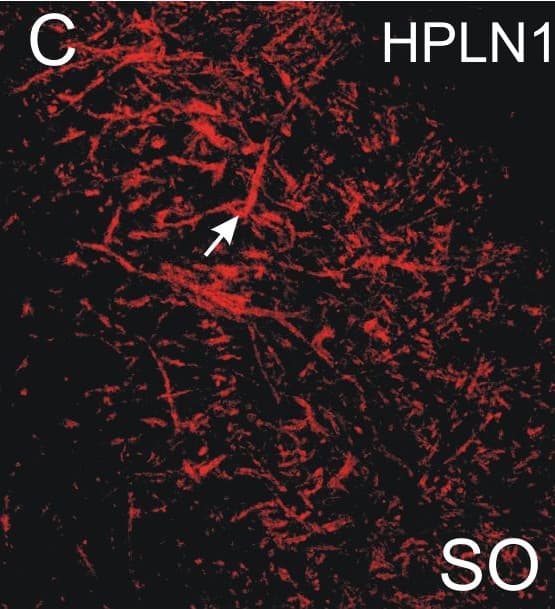HAPLN1 Products
HAPLN1 (also known as link protein and CRTL1) is a member of the hyaladherin family of hyaluronic acid (HA) binding proteins. Hyaluronan binding proteins are of two types; those with link modules, and those without. Link modules are 100 amino acid (aa) HA and protein-binding sequences that contain two alpha-helices and two anti-parallel beta-she...
12 results for "HAPLN1" in Products
12 results for "HAPLN1" in Products
HAPLN1 Products
HAPLN1 (also known as link protein and CRTL1) is a member of the hyaladherin family of hyaluronic acid (HA) binding proteins. Hyaluronan binding proteins are of two types; those with link modules, and those without. Link modules are 100 amino acid (aa) HA and protein-binding sequences that contain two alpha-helices and two anti-parallel beta-she...
| Reactivity: | Human |
| Details: | Goat IgG Polyclonal |
| Applications: | WB |
| Reactivity: | Human |
| Details: | Goat IgG Polyclonal |
| Applications: | WB |
| Source: | NS0 |
| Accession #: | P10915 |
| Applications: | Bind |
| Reactivity: | Human |
| Details: | Mouse IgG2a Monoclonal Clone #316119 |
| Applications: | WB |
| Reactivity: | Human |
| Details: | Rabbit IgG Polyclonal |
| Applications: | IHC |
| Reactivity: | Human |
| Details: | Rabbit IgG Polyclonal |
| Applications: | IHC, ICC/IF |
Recombinant Monoclonal Antibody
| Reactivity: | Human, Mouse, Rat |
| Details: | Rabbit IgG Monoclonal Clone #5O9U2 |
| Applications: | WB |
| Reactivity: | Human |
| Details: | Rabbit IgG Polyclonal |
| Applications: | WB |
| Applications: | AC |
| Applications: | WB |
| Applications: | AC |




![Immunohistochemistry-Paraffin: HAPLN1 Antibody [NBP1-84376] Immunohistochemistry-Paraffin: HAPLN1 Antibody [NBP1-84376]](https://resources.bio-techne.com/images/products/HAPLN1-Antibody-Immunohistochemistry-Paraffin-NBP1-84376-img0011.jpg)
![Immunocytochemistry/ Immunofluorescence: HAPLN1 Antibody [NBP1-85443] Immunocytochemistry/ Immunofluorescence: HAPLN1 Antibody [NBP1-85443]](https://resources.bio-techne.com/images/products/HAPLN1-Antibody-Immunocytochemistry-Immunofluorescence-NBP1-85443-img0007.jpg)
![Western Blot: HAPLN1 Antibody (5O9U2) [NBP3-16486] Western Blot: HAPLN1 Antibody (5O9U2) [NBP3-16486]](https://resources.bio-techne.com/images/products/HAPLN1-Antibody-5O9U2-Western-Blot-NBP3-16486-img0001.jpg)
![Western Blot: HAPLN1 Antibody [NBP1-59150] Western Blot: HAPLN1 Antibody [NBP1-59150]](https://resources.bio-techne.com/images/products/HAPLN1-Antibody-Western-Blot-NBP1-59150-img0002.jpg)

![Western Blot: HAPLN1 Overexpression Lysate [NBL1-11444] Western Blot: HAPLN1 Overexpression Lysate [NBL1-11444]](https://resources.bio-techne.com/images/products/HAPLN1-Overexpression-Lysate-Adult-Normal-Western-Blot-NBL1-11444-img0002.jpg)